Earthquake Early Warning - Blog
2025.10.16: ShakeOut / GrandeSecousse earthquake drill held in Canada
On Thursday, 16th October, approximately 60 million people around the world practised the Drop, Cover, Hold on response, in case of an earthquake. In Canada, over 865,000 people participated in this annual drill. They are therefore more likely to protect themselves when they receive an Earthquake Early Warning (EEW) or feel shaking.

In Quebec and Ontario, ShakeOut (Grande Sécousse) drills were held in numerous primary schools, Grande Secousse was promoted via social media platforms, and informational segments were given by one of NRCan’s eastern seismologists, on radio and television stations throughout the day – using this as an opportunity to promote the EEW system which will soon be launched in Quebec and eastern Ontario.
Le même sismologue a également animé un webinaire pour les coordinateurs municipaux sur les risques sismiques, la Grande Sécousse et les ASP, ainsi qu’un atelier sur les mêmes sujets pour les municipalités et les organisations de la région métropolitaine de Montréal. De plus, un paléosismologue régional a été filmé dans le cadre d’une série de vidéos d’information sur le risque sismique et la Grande Sécousse.

In British Columbia, the earthquake drill was hosted by the Provincial Legislative Assembly, and conducted throughout BC’s Parliamentary Buildings, by staff and visitors. The associated media event was emceed by BC Earthquake Alliance Vice President, and included a welcome by an Indigenous Counsellor from the Songhees Nation, and a speech by the Minister for Emergency Management and Climate Readiness for the province. A representative from the Insurance Bureau of Canada, spoke about the need for people and businesses to prepare for the earthquakes which would inevitably affect the province. Finally, one of NRCan’s western seismologists provided an overview of the EEW system. The day’s event was preceded, the evening before, by a public “Ask-the-Experts” webinar on earthquakes, associated hazards, and EEW.
In the Yukon, the Yukon Government promoted earthquake awareness and the Drop, Cover, Hold on response via social media and an information bulletin.
2025.09.22: Fieldwork in the Campbell River area
For three days last week, one of NRCan’s seismologists assisted a field technologist to service five earthquake monitoring stations on Vancouver Island, at Chemainus, Campbell River, Elk Falls, Gold River, and Myra Falls in Strathcona Park. Repairs and maintenance like this help to ensure the reliable, continuous operation of NRCan’s seismic and GNSS (global navigation satellite system) networks to monitor, alert (as part of the national Earthquake Early Warning system), and research earthquakes.
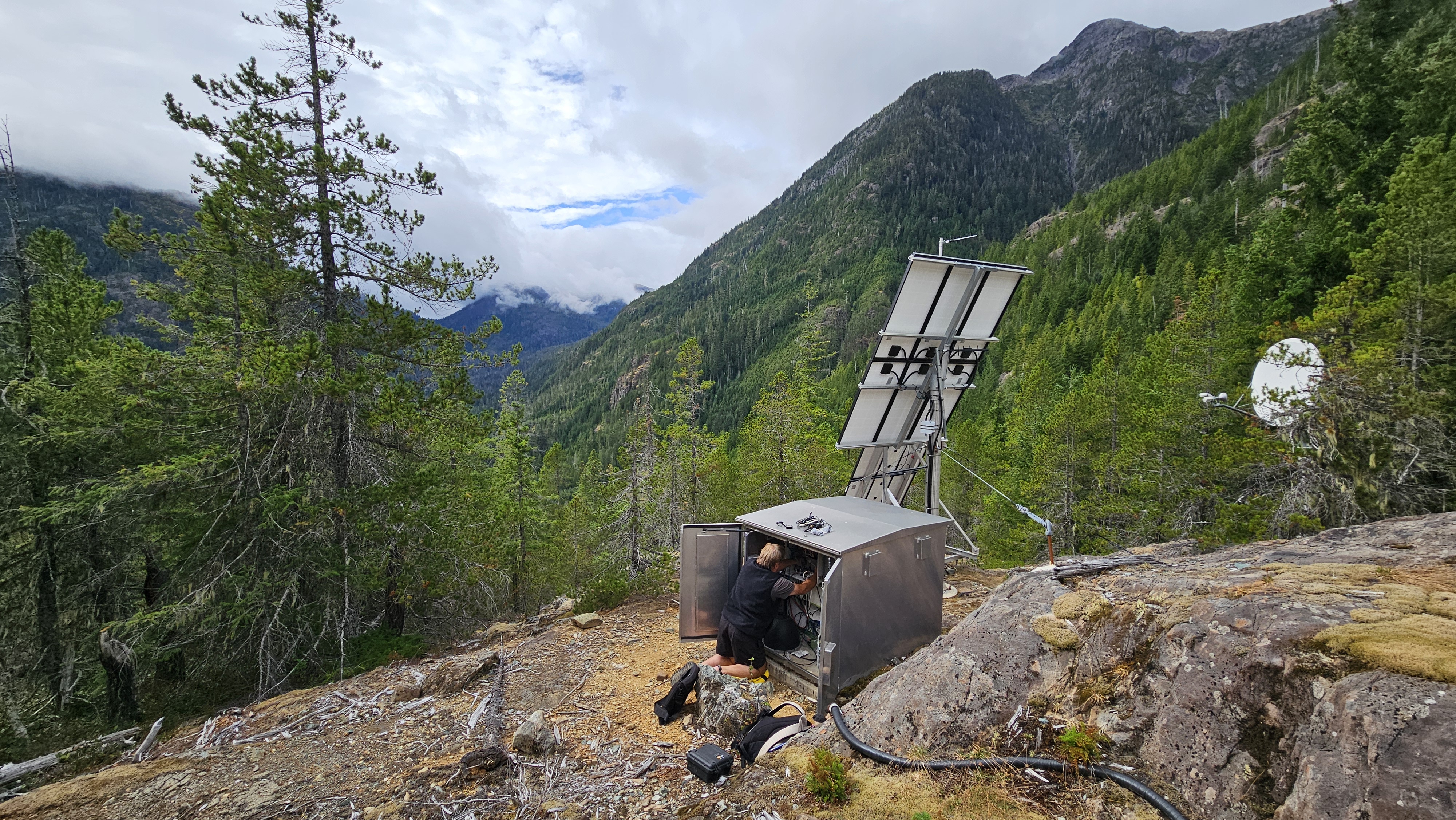
Many of NRCan’s stations are located in rugged and coastal terrains, requiring slow drives along rough roads, hiking, and, occasionally, helicopter or boat travel to access them. Fieldwork also takes place in Canada’s myriad of weathers, which can pose additional challenges. At the last station, near Myra Falls Mine, the duo were therefore relieved the weather was dry as they replaced the station’s GNSS monitoring equipment.
The fieldwork often gets supported by collaborator organisations; in this case, the crew were grateful for the assistance of staff at Myra Falls Mine, RCMP, BC Ferries, and West Coast Marine Terminal (Gold River).
2025.02.28: NRCan visits Haida Gwaii’s communities
Over the past week, NRCan’s earthquake seismologist Alison Bird and seismic network operations manager Lisa Nykolaishen travelled to Haida Gwaii. They visited the archipelago’s communities, briefing Masset Village Council and Skidegate Band Council on the Earthquake Early Warning system; giving presentations to the communities of Old Massett / Masset, Port Clements, Skidegate / Daajing Giids, and Sandspit; and meeting with the islands’ Emergency Managers and Planners.

Alison and Lisa also enjoyed a morning with the students of Agnes L Mathers Elementary School in Sandspit, where one of the School Shake project’s Raspberry Shake sensors is located. The students showed off their knowledge of the region’s earthquakes, and grilled Alison and Lisa on various aspects of geophysics.
2025.02.21: Southwest BC experiences its first Earthquake Early Warning
On 21st February 2025, an earthquake occurred northeast of Sechelt and north of Vancouver, British Columbia. The event caused the activation of the national Earthquake Early Warning (EEW) system, operated by Natural Resources Canada (NRCan). The EEW system functioned exactly as designed: automatically detecting the earthquake, assessing that it met thresholds for potential harm (magnitude ≥ 5, and shaking with MMI ≥ IV), and transmitting information to the National Public Alerting System (NPAS), indicating where people should be alerted. NPAS then distributed alerts to the public to cell towers aimed at the red polygon show in the map below, and via broadcast media (radios and televisions) within census subdivisions (chartreuse regions). Due to the complicated nature of alerting through cell networks, some phones outside the EEW region also received the alert.
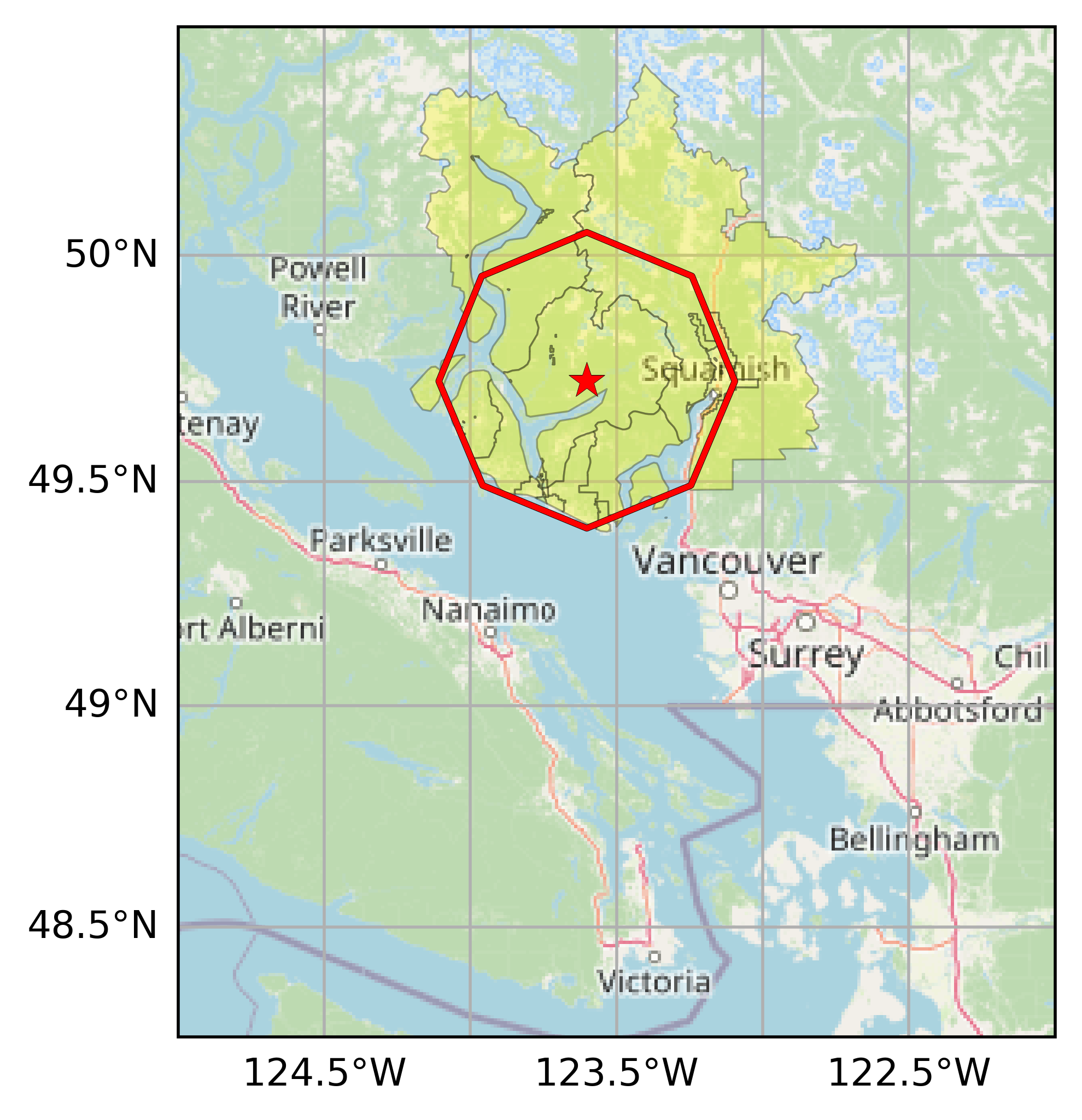
Following the earthquake, NRCan seismologists answered hundreds of calls from the media and public to explain details of the event. In addition, people submitted nearly 7,500 “Did you feel it?” reports of their experience of the earthquake, which are important for understanding the effects of this event and future earthquakes in the region. There have been no reports of damage or injury, but people reported feeling shaking as far as 300 kilometers from the epicenter.
This was an ideal opportunity for people to learn about EEW from a moderate earthquake, so that they can be ready to react when they receive an alert for a larger event.
2025.02.05: Historic Charlevoix earthquake of 1663
An earthquake with an estimated magnitude of 7 struck the Charlevoix region the evening of 5th February 1663. Records suggest it was felt throughout eastern North America. Damage was mostly to chimneys and to a few masonry walls and homes in Quebec and New England.
Earthquakes often result in secondary hazards. For example, numerous landslides and rock falls were reported along the St. Lawrence River, Saguenay River, Gouffre River, and St. Maurice valley. Landslides would have been especially likely if the earthquake followed a period of heavy rainfall in the region; while this is suspected, it has not been proven.
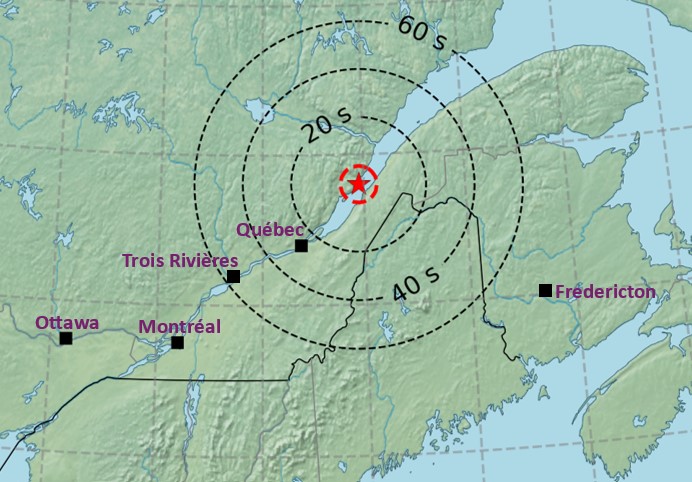
Were a similar earthquake to occur in this region once the EEW system is operational, Quebec City would have approximately 25 seconds of warning, Trois Rivieres ~55s, Fredericton ~80s, and Montreal ~90s. This would give ample time for protective actions to be taken by critical infrastructure facilities and people.
2025.01.06: UBC student’s analysis informs public safety initiatives
As noted in an earlier blogpost, a public survey was distributed last year, in anticipation of the launch of the Earthquake Early Warning (EEW) system. The survey was designed to gain an understanding of the public’s awareness of earthquakes, preparedness measures they had taken, and their anticipated response to EEW. Additionally, they were asked about earthquakes they had experienced.
Last summer, University of British Columbia co-op student Samantha Solis de Ovando worked with NRCan’s Alison Bird to analyse the results of this survey, which included creating maps to show geographic distribution of people’s responses and evaluations based on demographics.
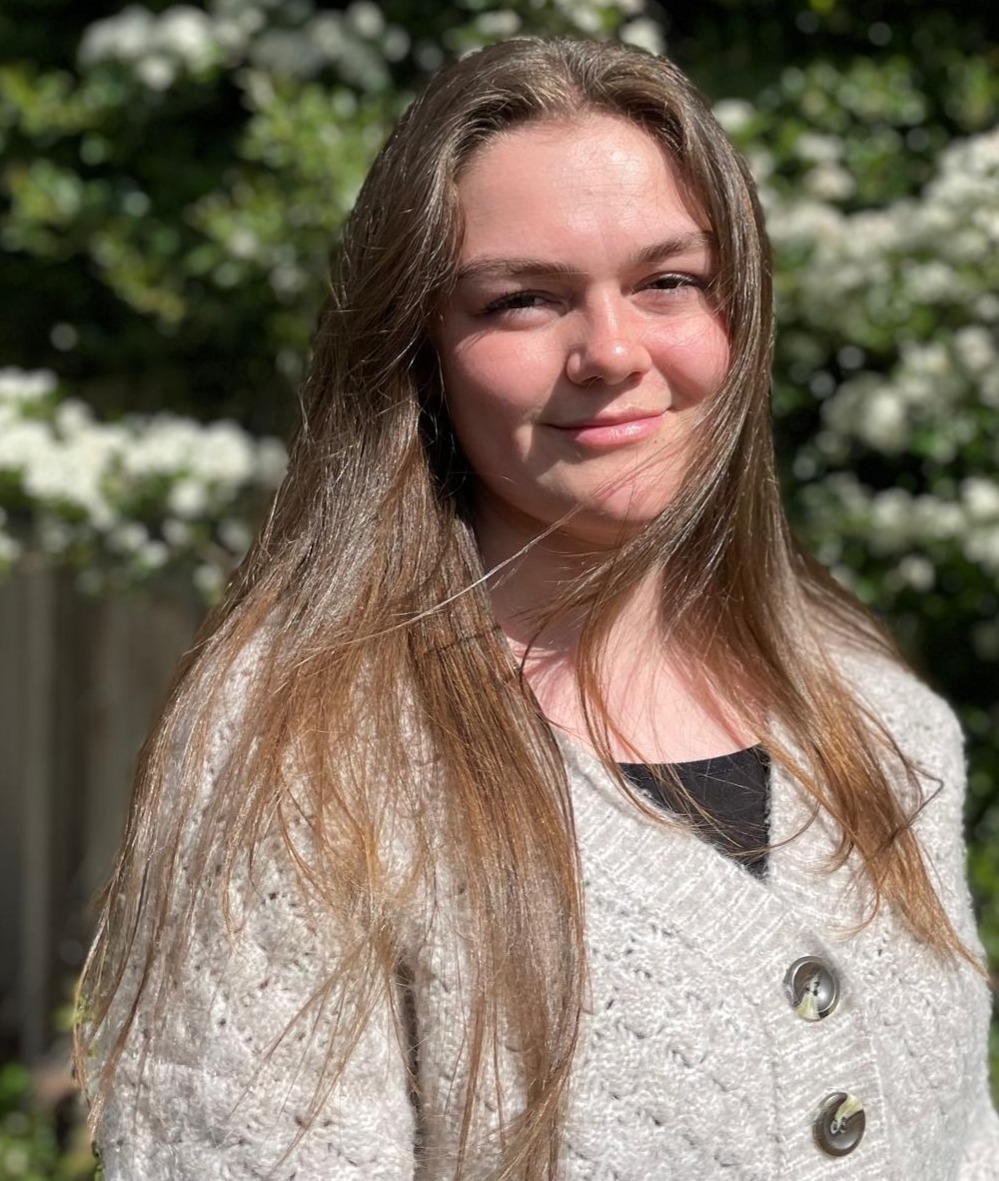
The study revealed that awareness of and preparedness for earthquakes is higher in the western EEW region (western British Columbia) than the eastern region (eastern Ontario and southern Quebec). In the west, the levels of awareness and preparedness are generally correlated to the level of seismic hazard. Samantha’s study revealed that Greater Vancouver is an exception, however, with lower levels of awareness and preparedness than the surrounding region, suggesting further public education initiatives are required to improve earthquake readiness. In the east, awareness and preparedness is highest in urban areas, whereas the levels are relatively low in rural areas of the provinces, indicating rural and remote communities might be targets of public education efforts.
Across both EEW regions, demographic analysis revealed that people tend to be more aware and prepared with age, but less likely to perform the earthquake protocol of Drop, Cover and Hold on. This response has been promoted in schools, since 2012 through ShakeOutBC and since 2013 through Grande Secousse. Those up to age of 30 are more likely to Drop, Cover and Hold On, suggesting school-based initiatives have been successful.

The survey analysis provides context around Canada’s readiness for earthquakes and EEW, and can guide public education initiatives and emergency management strategies to cultivate a culture of awareness within the seismically hazardous regions of BC, Ontario, and Quebec.
2024-10-17: ShakeOut / GrandeSecousse earthquake drill held in Canada
On Thursday, 17th October, over 825,000 people in Canada signed up to practise the Drop, Cover, Hold on response for earthquakes. They are therefore more likely to protect themselves when they receive an Earthquake Early Warning (EEW) or feel shaking.

In British Columbia, the ShakeOutBC earthquake drill was hosted by the Vancouver Fraser Port Authority (VFPA) and conducted in VFPA’s operations centre, by staff and visitors. Additionally, the adjacent Vancouver Convention Centre plaza held a public Emergency Preparedness Fair; NRCan’s Alison Bird, Tiegan Hobbs, and Riddhi Dave, along with visiting scientist Fiona Darbyshire, hosted a booth to showcase the new national Earthquake Early Warning System and earthquake research. Also on site was the popular Quake Cottage earthquake simulator, providing people with the opportunity to experience shaking from a strong (magnitude 8) earthquake, safely.
The associated media event began with a welcome by BC Earthquake Alliance President, Naomi Yamamoto, a welcome song by Alec Dan, from the Musqueam Nation, and speeches by dignitaries. Greg Moy, Insurance Bureau of Canada, spoke about the need for people and businesses to prepare for the earthquakes which would inevitably affect the province. Duncan Webb, VFPA, described the volume and diversity of goods and traffic through the port, and VFPA’s efforts to facilitate and prioritize emergency response in the region. And, Vancouver Mayor Ken Sim, outlined the earthquake mitigation measures being undertaken by the city and encouraged people to be prepared. Finally, Alison Bird answered questions about the region’s earthquakes and EEW.
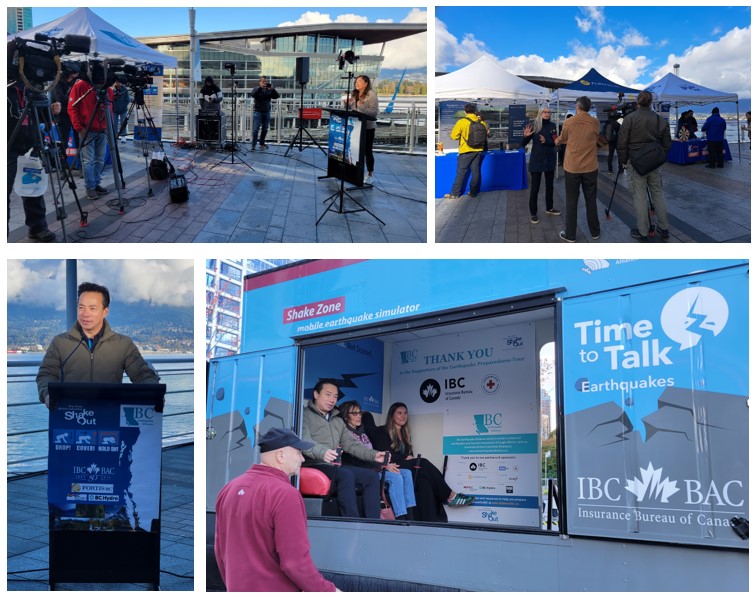
Numerous Shakeout drills were held in schools throughout Quebec, and informational segments were given by NRCan’s Chris Boucher, on radio and television stations (in Ontario and Quebec) throughout the day.
The preceding weeks showcased a brand new GrandeSecousse website, hosted by the Association des gestionnaires en sécurité incendie et civile du Québec (AGSICQ; in French only). Boucher and paleoseismologist Aube Gourdeau also delivered presentations on the importance of the GrandeSecousse/ShakeOut earthquake drill, and the upcoming EEW system soon to be launched in Quebec and eastern Ontario. They spoke to public safety coordinators, emergency planners and other people working in emergency preparedness at a seismic risk training session in Beaupré, as well as at the annual “Colloque sur la sécurité civile” held in Québec City.
In the Yukon, the Yukon Government promoted personal protection on their various social media channels, and their Health and Social Services department conducted internal refresher awareness on earthquakes.
2024-10-07: International Geodiversity Day
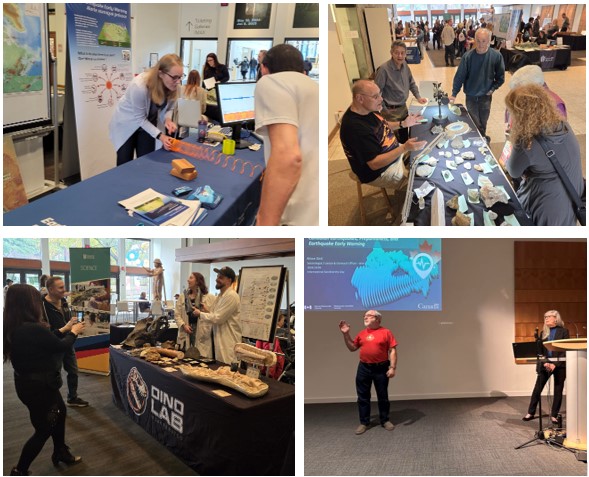
Saturday, 5th was International Geodiversity Day (IGD), promoting learning about everything that makes and shapes the Earth. Several NRCan scientists joined geophysical associates from other organisations, such as the British Columbia Geological Survey, the University of Victoria, and Dino Lab, to share their science with the public at an IGD event hosted by the Royal BC Museum in Victoria. NRCan's booths provided information and discussion on sedimentology, geology (with rock identification), tectonics, and earthquakes.
This was an ideal opportunity for NRCan's Alison Bird to speak with people about the newly launched Earthquake Early Warning system. Alison also delivered a presentation on the region's earthquakes and the EEW system, including how people will be alerted and how they should respond.
2024-09-16: EEW system sends its first alert!
On September 15th, the national Earthquake Early Warning (EEW) system sent its first alert to the public, when a magnitude 6.5 earthquake occurred just south of Haida Gwaii. The EEW system determined that strong shaking would occur in the southern region of Haida Gwaii's Moresby Island, so sent an EEW message to the National Public Alerting System (NPAS).
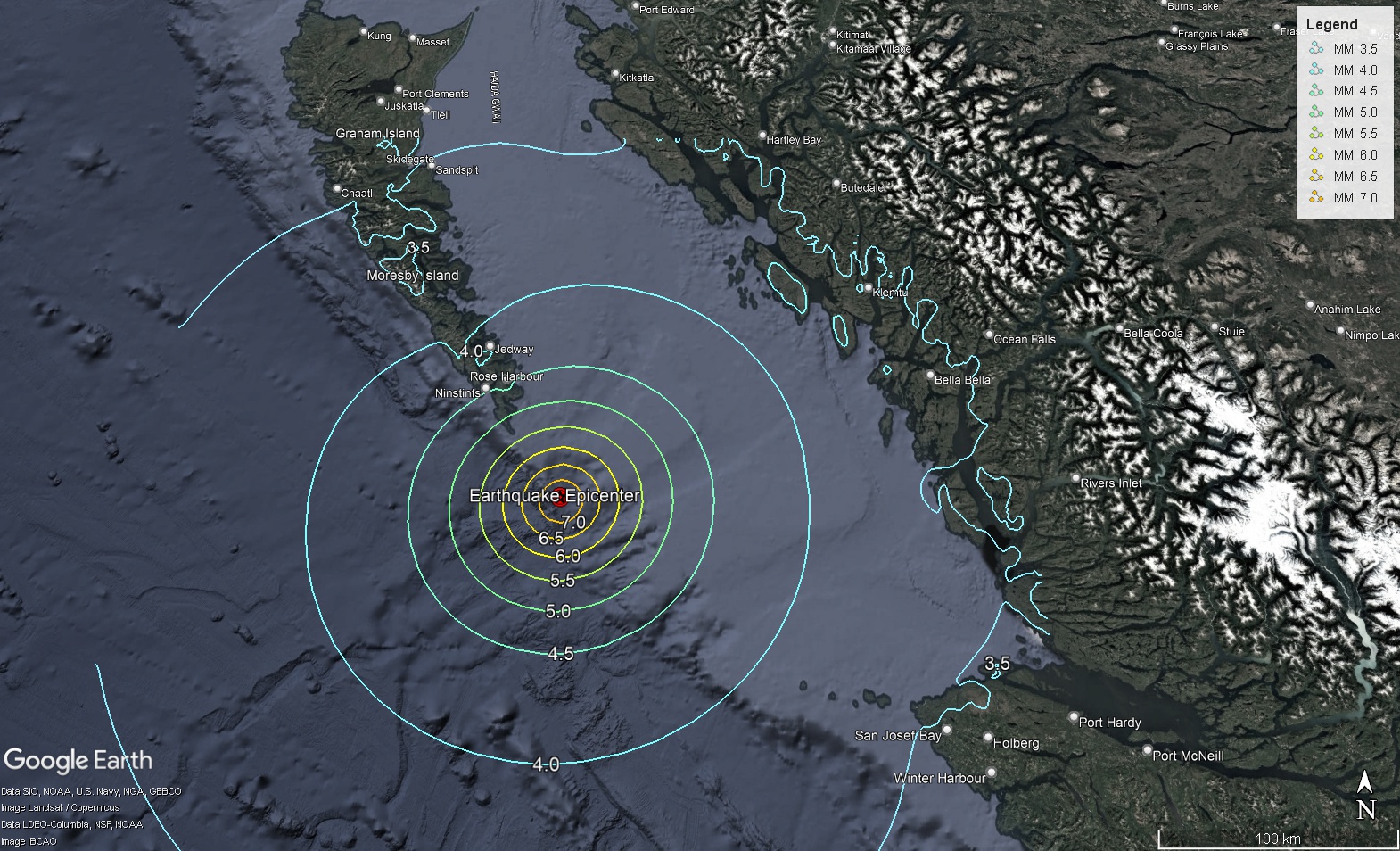
NPAS distributed radio and television alerts throughout the area's census division, which includes the town of Sandspit; people in Sandspit told NRCan's Field Researcher, Lisa Nykolaishen, they had received the alert a few seconds before they felt shaking. NPAS is also configured to alert via cell phone towers within the area of strong shaking; in this case, however, there were no cell towers in that remote (and generally unpopulated) area of the island.